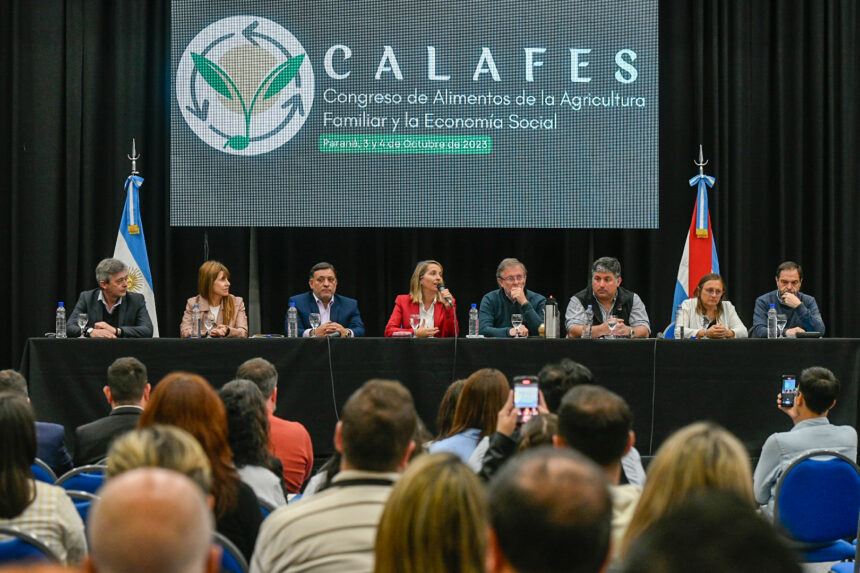
Glenda Magican environmental nutritionist, was encouraged to ask the question that worries many activists committed to the fight against agrochemicals: “What is the justification for SPRINT results were banned?”
The SPRINT is an international study where agrotoxins were detected in the blood of all Argentine participants. The INTA researcher, Virginia Aparicio, participated in the investigation. But INTA prohibited disseminating the results and prohibited Virginia from speaking. pic.twitter.com/M7jfTk5PCL
— Cítrica Magazine (@revistacitrica) October 4, 2023
It was within the framework of “Food Congress of Family Farming and Social Economy”held on October 3 and 4, in the city of Paraná, Entre Ríos.
Mariano GarmendiaPresident of WHILEresponded that “there was an initial error by INTA in how the project was approached but that we are trying to correct, we have to involve the Ministries of Health of the Nation, of the Province of Buenos Aires, we have to correct and work on it. , that’s what we’re in right now.”
However, the results of SPRINT They have been there since February and in June of this year there was going to be a presentation with the general Argentine results, in which I would participate Virginia Aparicioworker INTA Balcarce and researcher member of the study. That meeting was canceled and through a resolution signed by the president of INTA, Aparicio was prohibited from speaking to the press.
Still there is no official communication on this important topic of public healthbut it is not the first time that the INTA authorities express their complicity with the dominant agricultural model, the agribusiness. In 2017, they prohibited their workers from using the term “agrotoxic”, since “its use implies a negative evaluative position that presupposes an inadequate or inappropriate use of a technological alternative that, when used properly, should not constitute a risk to human or environmental health.” . The SPRINT results show the opposite.
What is SPRINT?
He SPRINT (Sustainable Plant Protection Transition: A Global Health Approach 2020/2025) is a project funded by the European Union that seeks to map and quantify the presence of agrotoxics in the environment and in humansand study for the first time the synergy of different pesticides, that is, their joint action. Each poison is not only harmful individually but together its harmful actions for socio-environmental health can be enhanced.
The purpose of the study is to provide scientific information for policies that seek reduce the use and impact of the most dangerous pesticideswith the goal of reducing them by 50% by 2030. The World Socio-Environmental Health DaySeptember 27, a virtual conference was held at the United Nations Assembly Scientific Summitwith the most relevant results of the team of European researchers.
Violette Geissen, Abdallah Alaoui, Daniel M. Figueiredo, Hans Mol, Maaike Gerritse, Fredya Debler, Dirk Goossens, Peter Fantke, Kayode Jeyede and Nelson Abrantes presented. Engineer Brian Longstaff Howard translated for the portal Ploff.net the main points of this talk.
The researchers explained the methodology and the main results obtained within the framework of each of their investigations, in which they quantified and analyzed the presence of agrotoxic residues in different ecosystems and in people in Europe and Argentina.
Among the main results and conclusions of the Conference, the “omnipresent” presence of mixtures or mixtures of pesticides (agrotoxics). That is, they are found everywherein ecosystems and in humans, and especially accumulated in “indoor dust.”
Dust samples in research Figueiredo reveal an accumulation of up to 120 different pesticides in it dust “indoors” of houses close to conventional cultural work, as well as houses close to organic cultural work.
It follows that the entry of pesticides into our bodies It could be both via diet due to foods with traces, as well as through the environment, mainly due to suspended dust.
However, the real risk to ecosystems and humans exposed to these mixtures in high numbers of hazardous agrochemical residues is not taken into account in current regulations. That’s why, goats He insisted on the need for regulations for the Use of Pesticides that assess, evaluate, and determine the real risk, including sensitive indicators that show what is happening and detect small changes in the variables that want to be measured.
In Figueiredo’s study, it was found that exposure to pesticides such as glyphosate and the AMPA (derived from glyphosate), was considerably higher when compared to other pesticides measured.
On the other hand, in the exhibition of Hans Mol on detection of agrotoxics in urine, blood and fecesit was shown that the frequencies are much older in Argentina and far surpass all the European countries studied.

The orange bars represent Argentina and the blue bars the rest of the sampled European countries. In it eje x (horizontal) the pesticides studied are shown, and in the Axis y (vertical) the percentage of samples in which they were detected.

The same trend is seen in detection in fecal matter.

Regarding glyphosate levels, it is seen that in Argentina – on the right – they are significantly higher compared to the other countries – on the left.
This is especially worrying because the presence of traces of pesticides in the intestine causes imbalances in the microbiome of this organ, that is, in the community of microorganisms that protect it. It is a study that models the impact of specific pesticides, an increase in cellular “stress” is observed, affecting the normal functioning of the intestine.
The analyzes of Debler y Groossens They focused both on the different transport routes of agrochemicals and on modeling systems to study the dispersion from the points where the pesticides are applied. Groossens noted that the transport through the air turned out to be much higher than he expected, reaching up to 40 km distance for long-term suspension periods.
Finally, other investigations studied the impact on aquatic ecosystemswhere all the species analyzed showed deterioration or deficiency due to being exposed to the agrotoxic mixtures.
As main conclusionsthe researchers replaced the Effects on human healththe need to establish new thresholds or limits of use of agrochemicals for many environmental matricesthe consideration of atmospheric transport in the regulations and unsustainability of pesticide use due to external costs on human and environmental health. It was estimated that 150 billion euros were the economic losses in 10 European countries. And it was repeated that the effect of pesticide mixtures It is much stronger when combined, than if it is only taken it takes the pesticide individually.
They highlighted that: “What we can conclude with all the SPRINT results is that we are all exposed, both us and the ecosystems. We are exposed to pesticide mixtures that are categorized as ‘hazardous’. “This causes human health effects, as well as monetary costs.”
And they added: “Of course, the question is, why are we still sticking to an agriculture that was born after the Second World War to produce as much food as possible per hectare? What led to this way of producing is the idea of never going hungry again, which was very valid after the war where many people went hungry and died of hunger. But today we know that we produce enough food for everyone. What there is is a distribution problem. We waste 30% of our food.
So, we can move towards a new modern agriculture… and this agricultural transition must be made urgently. A truly modern agriculture must include agroecological conceptsas well as robotics concepts and modern technology waiting to be implemented.”
The dissemination of this information and its corresponding interpretation is timely since the Next October 13, the European Union will have to vote on whether or not to re-authorize the use of glyphosateone of the agrotoxics, which with its derivatives such as AMPA, is one of those that appears the most in the sampling carried out.

For its part, in Argentinathe study sought 208 pesticides.
Anabel Pomarfrom the portal Lavaca, was able to access the results of participants in Buenos Aires territory. For the total number of samples, the presence of agrotoxics was found in a range of 6 a 13 pesticides in urine, 2 a 10 pesticides in sangre y 0 a 18 pesticides in fecal matter.
In addition, traces were also found in the environmental matrices, a range of:
- 6 a 22 pesticides in sample foods.
- 43 a 86 pesticides in household dust.
- 0 a 8 pesticides in crop grains.
- 1 a 12 pesticides animal urine y 0 a 16 pesticides in materia fecal animal.
- 5 a 25 pesticides in animal food.
- 0 a 12 pesticides in floors.
- 10 a 28 pesticides in superficial water.
Sampling in the province of Buenos Aires was carried out during the year 2021. In principle, the study contemplated mapping in 10 European countries but decided to include 73 samples of our country, for being Argentina the main exporter of soybeans for animal feed for the European market.
One of the possibilities raised by European scientists to reduce the use of pesticides is to reduce imports of products that use the most dangerous pesticides to force exporting countries to change production practices. In this sense, what is discussed in the coming days in the European Union may have an impact on our country.
Meanwhile, more and more voices are being raised to denounce the excessive fumigations and the increasing exposure to these poisons. The evidence of the harmful consequences for socio-environmental health does not stop growing, but only organization and fight from below can break with the political consensus of the main political forces to deepen agribusiness.
Source: www.laizquierdadiario.com

